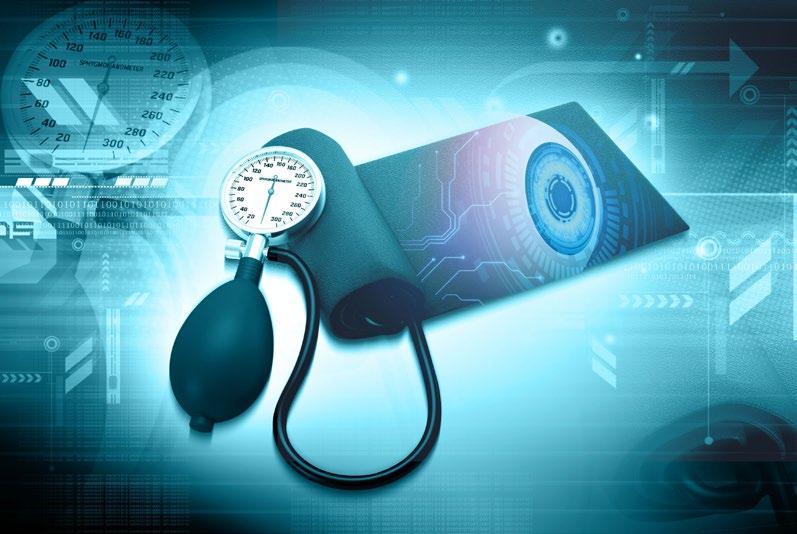
5 minute read
La hipertensión arterial y el ojo High blood pressure
El ojo y la medicina general
► LA HIPERTENSIÓN ARTERIAL Y EL OJO
Dra. Sònia Viver Oftalmóloga Ophthalmologist
La hipertensión arterial es una enfermedad sistémica que puede comprometer de manera severa órganos vitales como el cerebro, el corazón, los riñones y los ojos, entre otros. Su progresión es silenciosa, dañando paulatinamente los tejidos antes de que los efectos nocivos sobre los órganos sean clínicamente evidentes.
La retina es el único lugar del organismo donde podemos visualizar de manera directa los vasos sanguíneos mediante una técnica sencilla y no invasiva, la oftalmoscopia. Esto brinda la posibilidad de equiparar los daños en el fondo del ojo con los de otras partes del organismo.
La retinopatía hipertensiva es el conjunto de manifestaciones oculares que tienen lugar en la retina como consecuencia de la hipertensión arterial. A más presión arterial y tiempo de evolución, más probable que el daño ocular sea severo, y por ende, el del resto del organismo.
Existen otros factores que pueden agravar la retinopatía hipertensiva, como son: la arteriosclerosis, la edad avanzada, la diabetes, niveles altos de colesterol y triglicéridos o el consumo de tabaco, entre otros.
La gravedad de la retinopatía también dependerá del estado previo del árbol vascular retiniano y de la rapidez de instauración de la hipertensión; así podemos diferenciar entre:
►Retinopatía hipertensiva crónica La mayoría de los pacientes sufre esta variante. Suelen ser asintomáticos al inicio pero con la progresión de la hipertensión terminan presentando dificultades visuales. Se diagnostican
The eye and general medicine
► HIGH BLOOD PRESSURE AND THE EYE
High blood pressure is a systemic illness that may severely compromise the vital organs such as the brain, heart, kidney and eyes. It progresses slowly, gradually damaging the tissue before the harmful effects to the organs are clinically noticeable.
DIABETIC RETINOPATHY RETINOPATÍA DIABÉTICA
Aneurysm / Aneurisma Haemorrhages / Hemorragias
Cotton wool spots / Manchas de algodón
The retina is the only place in the body where we can clearly see the blood vessels using a simple and non-invasive technique: the ophthalmoscopy. It offers the possibility of equating the damage to the back of the eye with other parts of the body. Hypertensive retinopathy is a set of ocular manifestations that occur in the retina as a consequence of high blood pressure. The higher the blood pressure and the longer the time of evolution, the higher the likelihood of severe damage to the eye, and therefore, the rest of the body.
There are other factors that may aggravate hypotensive retinopathy, including arteriosclerosis, old age, diabetes, high cholesterol and triglycerides and smoking.
The seriousness of retinopathy will also depend on the retinovascular tree and the speed at which low blood pressure is established. We can distinguish between:
►Chronic hypertensive retinopathy The majority of patients suffer from this variant. They are usually asymptomatic at the start but as the blood pressure rises, they end up with visual problems. They are diagnosed by chance through an examination of the back of the eye, where we detect the following findings: • 1. Diffuse or focal decrease in vascular calibre. • 2. Pathological arteriovenous crossings (an artery compressing a vein, inhibiting blood flow). • 3. Changes in vascular reflex (difficulty visualising the blood inside the vessels). • 4. Retinal aneurysms: micro and macro aneurysms (abnormal vascular dilation both small and large respectively).
►Acute hypertensive retinopathy also called malignant or accelerated
It appears suddenly and is characterised by high pressure, bad headaches and a striking visual loss. In the clinical examination we will find: • 1. Retinal, preretinal, choroidal or vitreous haemorrhages (through vessel rupture). • 2. Soft or hard exudate (yellowish-white deposits from extravasation of plasma materials or from ischaemia). • 3. Papillary oedema (optic nerve inflammation). • 4. Macular oedema (inflammation of the central part of the retina).
►Treatment
There is no specific treatment for hypertensive retinopathy, blood pressure must be strictly controlled and maintained. Although some patients with very poorly controlled blood pressure may suffer permanent damage and visual sequelae, a dip in pressure translates into a significant fix for retinal lesions.
Therefore, any hypertensive patient is advised to undergo an ophthalmoscopy on a regular basis, which should be individualised based on the seriousness of the hypertension, age and the coexistence of other cardiovascular risk factors. ■
casualmente con un examen de fondo de ojo, donde encontraremos los siguientes hallazgos: • 1. Disminución del calibre vascular de manera difusa o focal. • 2. Cruces arteriovenosos patológicos (compresión de una arteria sobre una vena, dificultando el flujo sanguíneo). • 3. Alteraciones del reflejo vascular (dificultad en la visualización de la sangre en el interior de los vasos). • 4. Aneurismas retinianos: micro y
macroaneurismas (dilataciones vasculares anormales de pequeño o gran tamaño, respectivamente).
►Retinopatía hipertensiva aguda también denominada maligna o acelerada
Aparece de forma súbita y se caracteriza por presentar presiones muy altas, fuerte dolor de cabeza y acusada pérdida visual. En el examen clínico encontraremos: • 1. Hemorragias retinianas, prerretinianas, coroideas o vítreas (por rotura de vasos). • 2. Exudados blandos y duros (depósitos de color blanco-amarillento por extravasación de materiales del plasma o por isquemia). • 3. Edema de papila (inflamación del nervio óptico). • 4. Edema de mácula (inflamación de la parte central de la retina).

►Tratamiento
No existe un tratamiento específico para la retinopatía hipertensiva, sólo se debe controlar de forma estricta y mantenida la presión arterial. Aunque en algunos pacientes muy mal controlados pueden quedar daños permanentes y secuelas visuales, en general, un descenso de la presión se traduce en una resolución significativa de las lesiones retinianas.
Por ello, en todo paciente hipertenso es aconsejable una valoración oftalmoscópica periódica, que deberá individualizarse en función de la gravedad de la hipertensión, de la edad y de la coexistencia de otros factores de riesgo cardiovascular. ■













